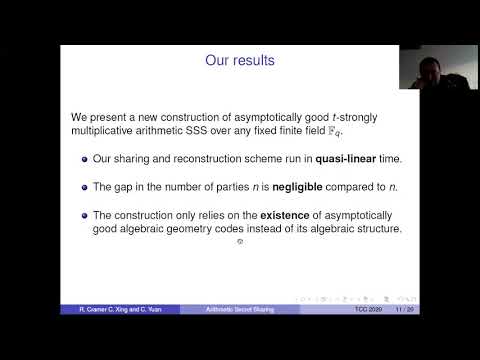CryptoDB
On the Complexity of Arithmetic Secret Sharing
| Authors: | |
|---|---|
| Download: | |
| Abstract: | Since the mid 2000s, asymptotically-good strongly-multiplicative linear (ramp) secret sharing schemes over a fixed finite field have turned out as a central theoretical primitive in numerous constant-communication-rate results in multi-party cryptographic scenarios, and, surprisingly, in two-party cryptography as well. Known constructions of this most powerful class of arithmetic secret sharing schemes all rely heavily on algebraic geometry (AG), i.e., on dedicated AG codes based on asymptotically good towers of algebraic function fields defined over finite fields. It is a well-known open question since the first (explicit) constructions of such schemes appeared in CRYPTO 2006 whether the use of ``heavy machinery'' can be avoided here. i.e., the question is whether the mere existence of such schemes can also be proved by ``elementary'' techniques only (say, from classical algebraic coding theory), even disregarding effective construction. So far, there is no progress. In this paper we show the theoretical result that, (1) {\em no matter whether this open question has an affirmative answer or not}, these schemes {\em can} be constructed explicitly by {\em elementary algorithms} defined in terms of basic algebraic coding theory. This pertains to all relevant operations associated to such schemes, including, notably, the generation of an instance for a given number of players $n$, as well as error correction in the presence of corrupt shares. We further show that (2) the algorithms are {\em quasi-linear time} (in $n$); this is (asymptotically) significantly more efficient than the known constructions. That said, the {\em analysis} of the mere termination of these algorithms {\em does} still rely on algebraic geometry, in the sense that it requires ``blackbox application'' of suitable {\em existence} results for these schemes. Our method employs a nontrivial, novel adaptation of a classical (and ubiquitous) paradigm from coding theory that enables transformation of {\em existence} results on asymptotically good codes into {\em explicit construction} of such codes via {\em concatenation}, at some constant loss in parameters achieved. In a nutshell, our generating idea is to combine a cascade of explicit but ``asymptotically-bad-yet-good-enough schemes'' with an asymptotically good one in such a judicious way that the latter can be selected with exponentially small number of players in that of the compound scheme. This opens the door to efficient, elementary exhaustive search. In order to make this work, we overcome a number of nontrivial technical hurdles. Our main handles include a novel application of the recently introduced notion of Reverse Multiplication-Friendly Embeddings (RMFE) from CRYPTO 2018, as well as a novel application of a natural variant in arithmetic secret sharing from EUROCRYPT 2008. |
Video from TCC 2020
BibTeX
@article{tcc-2020-30578,
title={On the Complexity of Arithmetic Secret Sharing},
booktitle={Theory of Cryptography},
publisher={Springer},
author={Ronald Cramer and Chaoping Xing and Chen Yuan},
year=2020
}

